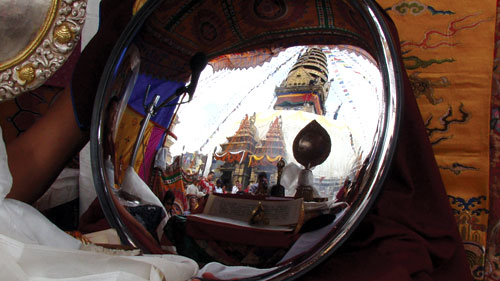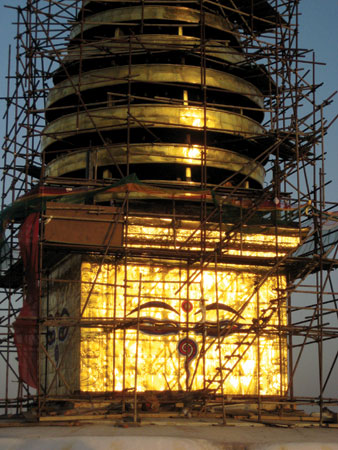 FAIREST OF THEM ALL: Mirror puja to remove the 'essence' of Swayambhu before renovation work started, 2008 |
Over the past two years, I have worked on the restoration of the physical form of Swayambhu. Here stands one of the world's most sacred monuments: a source of light and renewal, whose blessings sustain the power of enlightenment.
 Renovations underway at Swayambhu, 2010 |
Yet people continue to ask the seemingly simple question: "How old is Swayambhu?" But that is like asking the age of an ancient forest. The process of birth and decay occurs naturally in a forest, providing an on-going cycle for renewal and growth. The forest itself has no age.
Similarly, the historical Swayambhu has experienced many cycles, forming and reforming over the ages. Like the rings of a tree, each renewal of the sacred forms adds another layer of meaning and represents a new expression of faith. The Swayambhu we see now is a culmination of all the Swayambhus that have received offerings from devotees in the past.
Since the early 13th century, 14 major restorations of Swayambhu have been undertaken, roughly one every 50 to 100 years. The last was undertaken by the Tibetan lama Tokden Shakya Shri in 1918.
The current renovation of Swayambhu formally commenced on 1 July, 2008. The aim of this renovation was to restore the metal sections of the existing stupa to the splendour achieved by the last renovation. In so doing an opportunity was provided to restore and reinvigorate many traditional practices and artistic traditions. In this, the renovation was a time of renewal not just for the stupa, but for us as well.
Over 100 artisans and other individuals participated in the renovation, which involved no less than the removal, restoration, re-gilding (with pure gold) and reinstallation of the vajra, the dharmadhatu mandala, the nine shrines in the dome, the harmika, torans, cornice, and the thirteen rings. Thanks are due to the vajracharyas, priests, and lamas, the
 Lion face, during and after restoration |
Government of Nepal, and all the ministers and officials who granted permission to carry out this meritorious work and offered their advice and guidance; to all the artisans and workers who have given their skills and energy day after day; and to the Nepali citizens and their associations whose assistance and good wishes have been essential. Responsibility for funding was taken up by the Tibetan Nyingma Meditation Center (USA), including for 20 kilos of gold.
The Buddha taught that all compounded things are impermanent. This truth reminds us of the inevitable decay and passing of all things. It also offers us a priceless opportunity to reconnect to the sacred site of Swayambhu and ensure that its blessings continue. This moment of completion is also a time for renewal and a time to reflect on the power of change.�
READ ALSO:Buddhaland, Indu Nepal
The Buddha's message, Publisher's Note
Running on Empty
Himalyan Art revisited
Painting dreams


